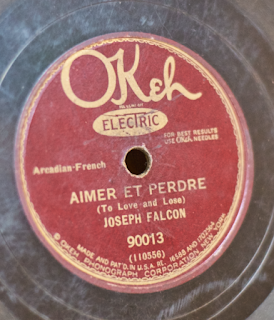His rough accordion sound was a fresh change from the earlier country swing material by the Hackberry Ramblers and Happy Fats. A huge fan of Amédé Ardoin, Lejeune exploded with power as a Cajun accordionist, playing so loud that he often drowned out a full electrified band in his recordings. Many of the Vanicors played behind Iry during this session including Milton and Ellis on fiddle and Ivy on guitar.
 |
| Billboard Magazine, mistakenly listing "Steve Fruge" and Iry Lejeune |
Even though producer Eddie Shuler created the Folk-star label specifically for Iry, he moved him onto his more widely sold Goldband label.
I had Folk-Star and Goldband. Then, later, after two or three records, I put him on Goldband because he was selling a lot of records. I said "Hell, I don't give a damn about Folk-Star, I want Goldband". I put him on Goldband then.3
Eh, yé yaille, chère jolie,
Toi, catin, 'gardez donc,
Moi, j'suis là dans les misères.
Jolie, je peux pas t'avoir.Moi, je n'peux plus dormir le soir,Avec tour mes jonglements,Et mon chagrin que j'ai pour toi.Catin, oublie pas ça.Eh, yé yaille, tu connais,T'après sentir ton mal,Parce que, toi, t'as toujors fait,Tout le temps mal avec moi.Tu m'as toujours maltraité,Fait quelque chose que je méritais pas.Mais, peut-être, que tu t'aperçois,Toutes tes grosses erreurs.Eh, yé yaille, tes chers 'tits yeux,Qu,est aussi canaille ça me ressemble,Que t'as quelque chose,Que tu veux me dire,Mais tu te sens pas cpable.Moi, je voudrais que tu me redis,Pour toi-même voir quo'faire que toi,Tu m'as mis dans autant de chagrin,Que moi je suis toujours dedans.
During this second session at KPLC in 1950 (or possibly 1952), Eddie Shuler had gotten the Vanicors and Iry together, laying down four sides, one of them being a fast paced two-step known as "Jolie Catin" (#102). The crude, yet direct, translation to "pretty whore" doesn't capture the deeper meaning in Cajun culture. It became a term of endearment, roughly translated to "pretty little doll", which had no negative connotation attached. It's Iry's version of the Amede Ardoin song "Eunice Two Step" and allegedly, the song was inspired by his cousin Geraldine Lejeune Morain. Doug Kershaw recalls playing with Iry:
I would set in with Iry & Nathan both. Iry had so much heart & feeling when he sang & played his accordion. I took that memory and applied it to myself when I grew up.
 |
| Crowley Daily Signal Feb 9, 1950 |
Eh, oh my, dear pretty one,You, little doll, look at this,I am here in misery.Pretty one, I can't have you.I can no longer sleep at night,With all I am thinking,And my sadness I have for you.Little doll, don't forget that.Eh, oh my, you know,You are feeling pain,Because you always did,Always did wrong by me.You've always mistreated me,Did things that I didn't deserve.Well, maybe you realize,All your big mistakes.Eh, oh my, your dear little eyes,That are so mischievous, it seems to me,That you have something,You want to tell me,But, you don't feel like you are able.I'd want you to tell me again,For yourself why you,Have placed me in all this grief,That I am still in.
Much later, Nathan Abshire would re-record the tune into his "Basile Breakdown".
- Iry Lejeune: Wailin the Blues Cajun Style by Ron Yule
- http://www.hearthmusic.com/blog/a-hearth-music-visit-with-94-year-old-cajun-fiddler-milton-vanicor.html
- http://arhoolie.org/eddie-shuler-goldband-records/
- Billboard Magazine, 1951
- http://andrethierry.com/zydeco/
Find:
The Legendary Iry LeJeune (Goldband, 1991)
The Legendary Iry LeJeune (Goldband, 1991)
Cajun's Greatest: The Definitive Collection (Ace, 2004)


















